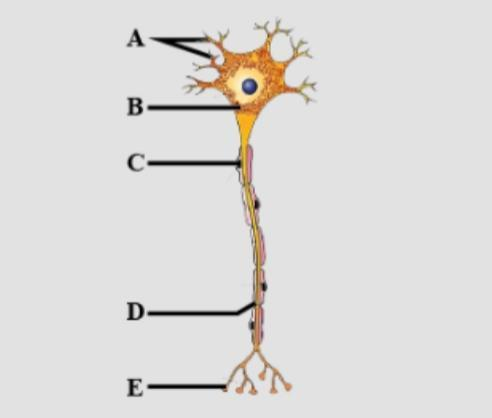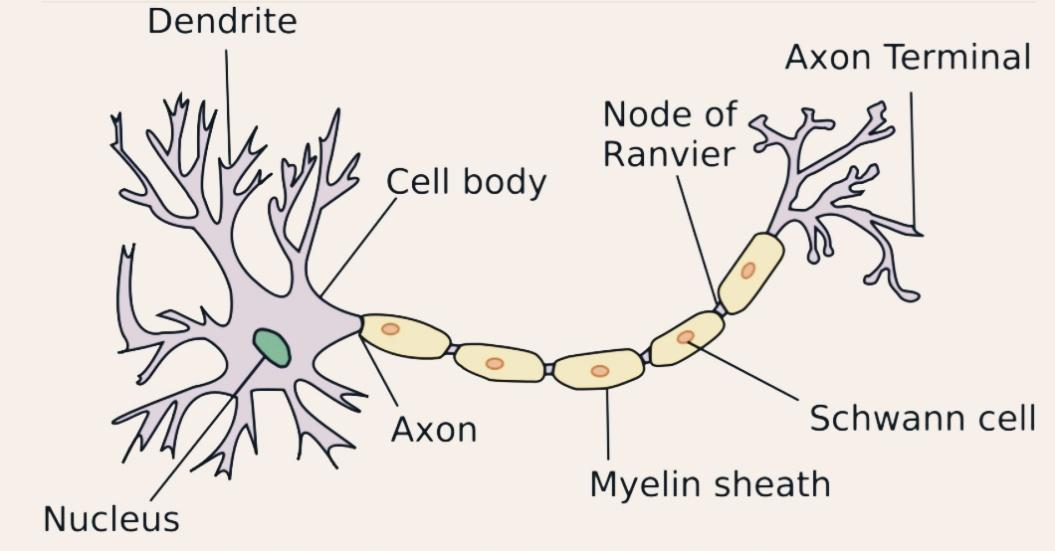
The given figure shows the structure of a neuron. Select the option that correctly identifies the parts labeled as A to E.

A. A – nerve fibers, B – cyton, C – Schwann cell, D – node of Ranvier, E – synaptic knob
B. A – Dendrites, B – Cyton, C- Schwann cell, D – node of Ranvier, E – synaptic knob
C. A – Dendrites, B – nerve cell, C – Schwann cell, D – synaptic knob, E – node of Ranvier
D. A – axon, B – cyton, C – nerve cell, D – node of Ranvier, E – synaptic knob

Answer
553.8k+ views
Hint:Neuron is a cell with many processes. This cell is modified for the conduction of impulse. Neurons are structural and functional units of the nervous system.
The nervous system is the most complex tissue of our body. Nerve cell has all cell organelles but it has many special modifications in a structure like dendrites and axons.
Complete answer: This diagram shows a multipolar neuron.
1. Nerve cell has a cell body or cyton that contains the nucleus and other cell organelles like neoplasm, mitochondria, Golgi- body, ER, Ribosomes, and centrosome.
2. Cyton has some processes that are called dendrites. These dendrites always receive the stimulation and conduct the impulse towards cyton.
3. A long process also develops from cyton that is called an axon. Most nerve cells have only one axon but some have two axons. Axon conducts the impulse away from cyton. Axon also has some micro-processes that are called axon telocentric or axon terminal. The end parts of these terminals are swollen called synaptic end bulbs or synaptic knobs.
4. In synaptic bulbs, there are membranous vesicles that are called synaptic vesicles.
5. In some neurons axon has a covering of myelin sheath. This sheath is made of fat and protein. These are called the myelinated axons. This is formed by Schwann cells.
6. Myelin sheath is not found continuously around the axon but around some parts of the axon it is absent these parts are called nodes of Ranvier.

Therefore option B- is correct that is A – dendrites, B – cyton, C – Schwann cell, D – node of Ranvier, E – synaptic knob
Note: Nervous cells do not divide lifetime. These are at the G0 phase.
In some nerve cells, only the axon is found and dendrite is absent; this is called a unipolar nerve cell. In some nerve cells, one axon and many dendrites are found called multipolar. If one dendrite and one axon both are present in the nerve cell it is called bipolar nerve cell.
The nervous system is the most complex tissue of our body. Nerve cell has all cell organelles but it has many special modifications in a structure like dendrites and axons.
Complete answer: This diagram shows a multipolar neuron.
1. Nerve cell has a cell body or cyton that contains the nucleus and other cell organelles like neoplasm, mitochondria, Golgi- body, ER, Ribosomes, and centrosome.
2. Cyton has some processes that are called dendrites. These dendrites always receive the stimulation and conduct the impulse towards cyton.
3. A long process also develops from cyton that is called an axon. Most nerve cells have only one axon but some have two axons. Axon conducts the impulse away from cyton. Axon also has some micro-processes that are called axon telocentric or axon terminal. The end parts of these terminals are swollen called synaptic end bulbs or synaptic knobs.
4. In synaptic bulbs, there are membranous vesicles that are called synaptic vesicles.
5. In some neurons axon has a covering of myelin sheath. This sheath is made of fat and protein. These are called the myelinated axons. This is formed by Schwann cells.
6. Myelin sheath is not found continuously around the axon but around some parts of the axon it is absent these parts are called nodes of Ranvier.

Therefore option B- is correct that is A – dendrites, B – cyton, C – Schwann cell, D – node of Ranvier, E – synaptic knob
Note: Nervous cells do not divide lifetime. These are at the G0 phase.
In some nerve cells, only the axon is found and dendrite is absent; this is called a unipolar nerve cell. In some nerve cells, one axon and many dendrites are found called multipolar. If one dendrite and one axon both are present in the nerve cell it is called bipolar nerve cell.
Recently Updated Pages
Master Class 11 Economics: Engaging Questions & Answers for Success

Master Class 11 English: Engaging Questions & Answers for Success

Master Class 11 Social Science: Engaging Questions & Answers for Success

Master Class 11 Biology: Engaging Questions & Answers for Success

Class 11 Question and Answer - Your Ultimate Solutions Guide

Master Class 11 Business Studies: Engaging Questions & Answers for Success

Trending doubts
What is meant by exothermic and endothermic reactions class 11 chemistry CBSE

10 examples of friction in our daily life

One Metric ton is equal to kg A 10000 B 1000 C 100 class 11 physics CBSE

Difference Between Prokaryotic Cells and Eukaryotic Cells

What are Quantum numbers Explain the quantum number class 11 chemistry CBSE

1 Quintal is equal to a 110 kg b 10 kg c 100kg d 1000 class 11 physics CBSE




